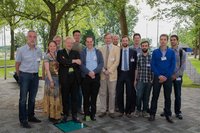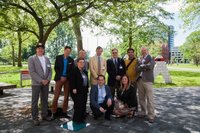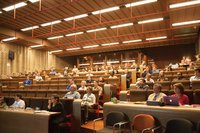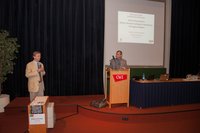The research of the Distributed and Interactive Systems (DIS) group was covered at the CWI Lectures 2014 on 22 May 2014 at CWI, Amsterdam. Theme of this event was Socially-Aware Multimedia, covering the areas of Multimedia Systems, Content Analysis, Human-Computer Interaction and Hypermedia. Eight internationally recognized speakers highlighted past achievements and reflected on future possibilities for new research challenges. The Lectures 2014 were organized in recognition of former DIS group leader prof. dr. Dick Bulterman. After nearly 25 years of tenure at CWI, he became President of the FX Palo Alto Laboratory (FXPAL) in California in 2014.

Distributed and Interactive Systems group at the CWI Lectures, 22 May 2014
SESSIONS:
- EC funding of Multimedia Projects: Loretta Anania
- Time Travel with WABAC machine: Klara Nahrstedt
- Past, present and future of semantic information representation: Frank van Harmelen
- Something about content-based searching in multimedia systems: Alan F. Smeaton
- Richer documents, richer human-computer interaction – a progress report: Andries van Dam
- The Redefinition of Content: David A. Shamma
- The Space in Between: Marian F. Ursu
- Digital Life in 2025: Lawrence A. Rowe

Speakers (from left to right): Back row: Marian Ursu, Frank van Harmelen, Andries van Dam, Dick Bulterman, Lawrence Rowe, David Shamma, Alan Smeaton. Front row: Klara Nahrstedt, Pablo Cesar, Loretta Anania.
Multimedia Systems
EC funding of Multimedia Projects
Loretta Anania
European Commission, Belgium
Loretta Anania traces the thread of multimedia research and advanced communication developments as part of the collaborative EU projects and programmes: from the early days of ESPRIT and RACE to the pioneering futuristic work of the Future & Emerging Technologies vision, to the current work. The main focus is to promote user-centered design principles, and a demand-side approach to systems innovation.
From MBone and Web-based Multimedia to Experiential Multimedia Systems: Time Travel with WABAC Machine
Klara Nahrstedt, ACM Fellow
University of Illinois at Urbana-Champaign, USA
The last 25 years have been incredible in the research area of multimedia systems since the level of innovations, achievements, and excitement have been unprecedented to any other research area in such a short time. Just thinking of the changes that YouTube, Skype, Flickr, Facebook, Voice-over-IP telephony, mobile TV brought to our society is extraordinary. Using the WABAC machine, we will transport the audience in time to visit important events in multimedia systems history. “Sherman, set the WABAC machine to” 1987-1988 with its’ first digital voice system, the Etherphone; to 1992 when MBone, vic, vat and IP multicast enabled first video and audio conferencing systems; to late 1990th and early 2000th, when collaborative conferencing systems with Voice-over-IP, SIP, RTP/RTCP, and web-based multimedia concepts flourished; to late 2000th when DASH, WebRTC, 3D streaming and delivery concepts emerged and enabled immersive telepresence and interactive digital television environments; and to 2025 when sharing, experiences, habits, activities were understood by our digital surrounding environments and boundaries between conferencing and on-demand environments blurred towards experiential multimedia environments enabling seamless socially-aware telepresence participation and television interactions. Klara Nahrstedt takes you on a journey on the “WABAC machine”!
Web and Content
If our computers could only understand our multi-media... Past, present and future of semantic information representation
Frank van Harmelen
VU University, the Netherlands
If our computers would understand the content of our multi-media presentations, then we could automatically generate presentations that were beautiful and meaningful, we could re-use media-items, we could find and combine presentations, etc. If only... Frank van Harmelen will review the progress that has been made in machine-accessible representations of the semantics of information over the past decade. He sketches the current state of the art, and tries to draw up a research agenda of the most pressing open questions.
Something about content-based searching in multimedia systems
Alan F. Smeaton
Dublin City University, Ireland
For decades, almost since the first valve was turned on in a computer or the first 9-track computer tape machine started whirring, we have been obsessed with using computers for automatic analysis of content. From the early days of Gerry Salton’s work on information retrieval on text abstracts in the 1960’s through to full text search and probabilistic, ranked search outputs, then search on image media, then video, then search through web pages and now all kinds of web-accessible content, real time search, social media search, personal libraries and lifelogs, we always focus on analysing the content so we can then find the “right stuff” at the right time, in the right place, etc. But guess what, after over a half-centrury of chasing the holy grail of trying to understand what it is we’re searching through, or for, we still don’t understand it. And maybe we don’t need to. Maybe that old marketing catchphrase is true that it’s not what you say but what others say about you that matters. In this talk Alan Smeaton explores the juxtaposition of content-based and context-based information access, ask which is more important and whether having a differentiation really matters.
Richer documents, richer human-computer interaction – a progress report
Andries van Dam, ACM Fellow
Brown University, USA
In this talk Andries van Dam reviews his nearly five decades of experimentation with hypertext/hypermedia and human-computer interaction via graphical displays. The focus is on several applications, all designed to feature touch (and pen) interaction. These applications include a rich hypermedia framework that supports an unbounded 2D workspace and fine-grained, bidirectional hyperlinks between documents; an art gallery application designed for touch manipulation of large-format 2D linked artworks; a purely gestural interface for making precise 2D drawings such as logos and icons and other precise diagrams without a huge learning curve; and a visual interface to spreadsheets and SQL databases allowing visual construction of queries, joins and other operations to allow tactile and graphical exploration of multiple data sets by novice users. Van Dam's focus is the evolution of rich human-computer interaction, concluding with an overview of interesting problems still to be solved.
Presentation - part 1 (pptx)
Presentation - part 2 (pptx)
WARNING: Large files
Socially-Awareness
The Redefinition of Content
David Ayman Shamma
Yahoo! Research, USA
Once singularly defined at looking at clusters of pixels to form content, multimedia has grown well beyond. Through technology, the act of photo and video taking and sharing now includes capturing more signals (location, photographic style, and social closeness) than what was possible with historical photo emulsion. This expands how photographers, both camera phone and professional alike, engage in their everyday practice and presents new challenges for researchers in the areas of geographic annotation of photographs and regions, community congregation online, and social engagement -all of which define and construct the social photograph as the new understanding of multimedia content.
Presentation not available
The Space in Between
Marian F. Ursu
University of York, UK
Marian Ursu delineates a new creative space supported by four pillars: interactive TV narration, narrative interaction with user generated content (UGC), live video communication in social groups, and video mediated performance. Interactive TV narration refers to the ability of TV programmes, broadcast or individually watched, to adapt at viewing time to input received or extracted from their viewers. They are automatically edited based on user interaction. They require authors to create narrative spaces which are interpreted at viewing time into individual personalised narrations. The same metaphor can be extended to the consumption of UGC, but the proposition, here, is harder due to the sparseness of annotations and their possible inaccuracy. However, the size of the UGC repositories and the interfaces through which they are created make the proposition feasible. The metaphor of interactive TV can also be extended to live video-mediated social communication, which employs complex group communication topologies. Here, recounting screen grammars ought to be replaced by communication screen grammars, metadata annotations by interaction cue extraction, and automatic editing by automatic mixing and camera control. Finally, live video communication can be extended to even more complex communication topologies, such as those required by mediated co-performance to remote and active audiences. These four forms of mediated communication define a rich creative space in between that is yet to be explored. Ursu gives a brief glimpse of it.
Digital Life in 2025
Lawrence A. Rowe, ACM fellow
FX Palo Alto Laboratory (FXPAL), USA
What role will multimedia play in everyday life in 2025? Lawrence Rowe discusses current experience, that is, “Digital Life in 2014,” and makes bold predictions about how life is likely to change in the next 11 years. Research opportunities to work towards this future are being discussed.

The audience at the CWI Lectures 2014

Dick Bulterman (l) and Andries van Dam (r) during Van Dam's talk
